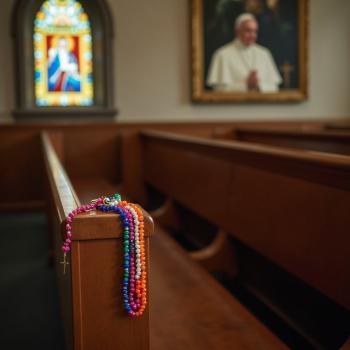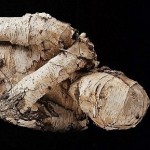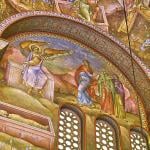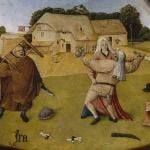She preferred to be called Mother Bailey. She was a stately Scottish woman; tall and handsome with wild blonde-gray hair that no matter how desperately she tried to secure it, frizzed and blew in all directions. Her eyes were a steely-blue and reminded me of thin ice over a lake. Much like her homeland she was rugged and sturdy.
Though she gave an air of fixed and singular determination, she was known for her wicked sense of humor that was subtle and witty. I was often a recipient of this humor and rarely caught on until I saw the glint in her eyes. She seemed to draw delight in my simple trusting nature.
Mother Bailey was a devout Presbyterian and followed the rules of her church, one of which she believed included frugality. She wasted nothing and bordered on the edge of hoarding, except that she willingly gave away whatever she had.
She lived in Pennsylvania with her English Cocker Spaniel named Tillie, also a blonde. This particular area of Pennsylvania reminded her of home; hilly, rocky, windswept and a neighborhood clannish in nature. Her only frustration with the region was her inability to grow a decent patch of heather in the garden. I wondered if this inability was due more to the activities of her energetic dog than the environment. Whenever we would walk about the sloping gardens, care would need to be taken so as not to sprain an ankle in one of the many digs Tillie left behind.
Listening to Mother Bailey talk gave rise to wonder and curiosity about her native land. Her tongue would roll and lilt as she spoke of land and sea. Words like glens and straths or firths and links peppered her descriptions. I would set a mental note to check the encyclopedias when I got home.
Being Scottish, and as I mentioned, frugal in every regard, Mother Bailey repurposed everything—long before it was fashionable. And her home reflected this habit, especially her kitchen. It was a galley style kitchen with one end open to the central hallway and the other open to the dining area with a half-wall counter dividing the room.
Every surface, shelf and ledge were filled to capacity with half-hazard stacks categorically organized. A colorful mountain of seasonal and holiday napkins, some only slightly used, spilled over onto the canning jars filled with plastic cutlery—being utilized more frequently than the drawer of pristine flatware.
The white porcelain enamelware table, with red edged extender leaves and chrome legs, bore the brunt of the stacking. Only a small half-moon space at the front edge of the leaf remained open for her to work. The organized clutter sloped up and away to rest against the gold floral papered wall.
Boxes of loose tea and half used tea-balls rested nearest the front. Emptied bread bags lay half folded under the casual mound of English muffins, bannock cakes, and partial loaves of assorted breads. Cartons and cans filled the remaining space in an uphill climb with the summit of the pile stacked with steel cut oats imported from Scotland. Mother Bailey was a bit of a snob when it came to her beloved oats.
When I had come to visit her one afternoon, she had intended to make chowder for our ‘sup’. With bacon fat leftover from breakfast, she sautéed the onions as we talked. A barely concealed fear of a kitchen fire raced through my thoughts as I observed the nearness of her stacks to the lighted range. Rummaging through the cans on the counter to her right she pulled out whole corn and from the freezer a bag of lima beans. Opening them she added them to the pot. I had not eaten limas before and asked if they were like navy or black beans. “Tis neither” was all she said while dipping a wooden spoon into the stock, pulling up a plump green lima for me to taste. I enjoyed its creaminess, like butter wrapped in a pale green skin.
Mother Bailey explained that succotash was a baked dish of corn, limas and evaporated milk. She had adapted the ingredients to make chowder, “for the soups are healthier you know.” A practical woman, she often used boxed potato flakes when she had no leftover mashed. This is an adaptation of her recipe, God rest her soul.
Succotash Chowder
4 strips thick bacon, diced, fried and drained, reserving about 1 tbl. of the grease
1 medium onion, diced
30-36 oz. chicken broth (2 large cartons or cans) or equivalent using bouillon paste
¼ tsp celery seed
¼ tsp thyme
10 oz. frozen lima beans (or canned, drained)
10 oz. frozen whole kernel corn (or canned drained), or for a sweeter chowder use corn stripped from the cob
1-1 ¼ c. potato flakes, or equivalent leftover mashed thinned with some of the milk
1 c half-and-half, or equivalent whole milk (do not use skim or low fat) mixed with a small can of evaporated milk
Pepper to taste
Cook the bacon bits until well done but not overly hard. In soup kettle add the bacon drippings and sauté the onions until translucent. Add the broth, celery seed, thyme, limas and corn. Boil gently for 15 minutes. Whisk into soup the milk and potatoes. Add bacon bits. Add pepper to taste and simmer until thickened.
I usually use leftover mashed potatoes for this chowder. I find that boxed potatoes work very well to thicken up a soup, but use them in moderation for you can quickly wind up with a succotash mud. You can also use corn starch to thicken.
Enjoy!















